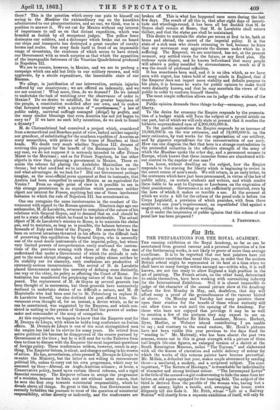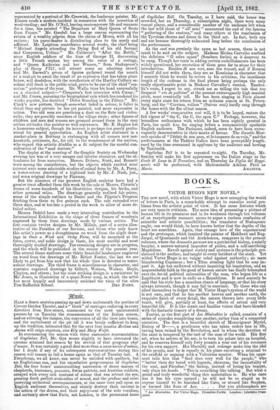3rts.
THE PREPARATIONS FOR THE ROYAL ACADEMY. THE ensuing exhibition at the Royal Academy, so far as can be ascertained from general rumour and a personal inspection of a few of the forthcoming works, is not likely to prove of more than average excellence. It is to be regretted that our best painters have not made greater exertions than usual this year, in order that the modern British school might be represented at its best at a time when we shall have so many foreign critics amongst us—critics who, it is well known, are not too ready to allow England a high position in the art of painting. The French artists, on the other hand, determined to outdo themselves, have been working with unremitting industry for the International Exhibition. Still it is almost impossible to judge of the character of the annual picture show at the Academy before the first Monday in May, and, doubtless, that day will afford many a proof of the groundlessness of the rumour hinted at above. On Monday and Tuesday last many painters threw open their studios for the benefit of those whose curiosity will not allow them to wait until the opening of the Academy. For those who have not enjoyed that privilege it may be as well to mention a few of the pictures they may expect to see on that occasion. Whether Sir Edwin Landseer, Messrs. Herbert, Dyce, Maclise, or Webster intend contributing I am unable to say ; and contrary to the usual custom, Mr. Hook's pictures have not been visible this year previous to the days fixed for "sending iu." Mr. Mulready, who has been absent the past two seasons, comes out in this in great strength with a picture of three half-length life-size figures, an enlarged version of a sketch at the South Kensington Museum, called "The Toyman," and elaborated with all the finesse of execution and subtle delicacy of colour for which the works of this veteran painter have become proverbial. Mr. Millais, a. defaulter last year, makes ample atonement sending three—a meditcval, a modern, and a scriptural subject. lie most important, " The Return of Hostages," is remarkable for individuality of character and strong brilliant colour. "The Intercepted Letter" is the title of the second—a girl endeavouring to hide the same from her fathex, an old squire equipped for the hunting field. The subject of the third is derived from the parable of the woman who, having lost a
piece of money, lights a candle, and, sweep' the house, seeks diligently till she finds it. Mr. Frith, whose " le at a Railway Station" will shortly form a separate exhibition of itself, will only be
represented by a portrait of Mr. Creswiek, the landscape painter. Mr. Elmore sends a modern incident in connexion with the invention of wool-carding; and Mr. O'Neil, leaving contemporary life and manners for a time, has painted " The Departure of Mary Queen of Soots from France!' Mr. Goodall has a large canvas representing the return of a wealthy p4.rim from the shrine of Mecca, with all his retinue; his purse-bwier is distributing alms to the needy and afflicted. Mr. Leighton contributes several works, the chief being "Michael Angelo attending the Dying Bed of his old Servant and Companion, Urbino." Mr. Calderon's "After the Battle," some English soldiers of the time of George II. discovering a little French orphan boy among the ruins of a cottage, and " Queen Katherine and her Women," from Shakspeare's play of limey VIII., will attract many an admiring crowd, and Mr. Barwell's group of figures gathered round the mouth of a coal-pit to await the result of an explosion that has taken place below, will doubtless, with the recollection of the Hartley Colliery ac- cident still fresh in the public mind,prove to be one of the chief "sen- sation" pictures of the year. Mr. Wallis tries his hand successfully on a classical subject—" Cleopatra's first interview with Cesar; and Mr. Crowe, pursuing the biographical vein which has rendered his works popular, has depicted "Defoe Standing in the Pillory." Mr. Clark's new picture, though somewhat faded in colour, is fuller in detail than any picture he has yet painted, and more expressive in action. Two old men are practising a duet on the flute and violon- cello; they are possibly members of the village choir; other figures of children and men and women are grouped around these in the easy artless attitudes this painter so well represents. Mr. E. Hughes has a humorous subject, though its interest is perhaps too purely profes- sional for general appreciation. An English artist stationed in a market-place in Brittany is exchanging with all comers new nec- kerchiefs, petticoats, &e., for old, to the wonderment of the natives, who regard this artistic Aladdin as a fit. subject for the careful con- sideration of the "mad doctors."
The display at the meeting of the Graphic Society on Wednesday evening last was of a very meagre and inferior character, and the at- tendance far from numerous. Messrs. Dobson, Stark, and Bennett were among the contributors, but the objects which excited most interest were some admirable studies of animal form by Mr. A. Perry, a water-colour drawing of a highland loch by Mr. J. Nash, jun , and some original drawings by Flaxman. But the admirers of our greatest English sculptor have had a greater treat afforded them this week by the sale at Messrs. Christie's rooms of some hundreds of his illustrative designs, his books, and other personal relics. The drawings generally realized fair prices, some of the simple outlines to Dante and the Pilgrim's Progress fetching from three to five guineas each. The sale extended over three days, and at too late a period in the week to allow of more de- tailed notice.
Messrs. Daiziel have made a very interesting contribution to the International Exhibition in the shape of three frames of woodcuts engraved by them from drawings made by various artists. The first contains twelve designs by Mr. Millais, part of a series illus- trative of the Parables of our Saviour, and those who only know this artist's power as a draughtsman on wood from the slight draw- ings in Once a Week and Orley Farm, will be surprised at the force, power, and noble design in these, his most careful and most thoroughly studied drawings. The remaining designs are in progress, and the whole will be published in the course of the present year. The second frame encloses some thirty beautiful landscapes engraved on wood from the drawings of Mr. Bitket Foster, the last we are likely to get from him now that his whole time is devoted to water- colour drawings. The third frame is miscellaneous in character, and contains engraved drawings by Gilbert, Watson, Walker, Doyle, Clayton, and others ; but the most striking design is a caricature by Mr. Jones, in illustration of a quasi-Norse song, in which the artist has most happily and humorously satirized the vices of the ultra































 Previous page
Previous page